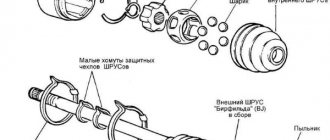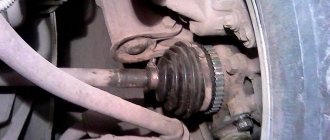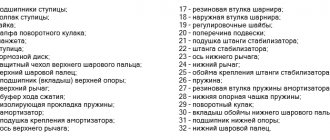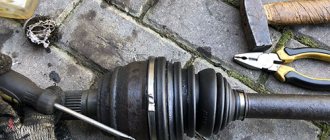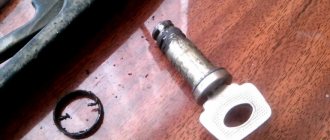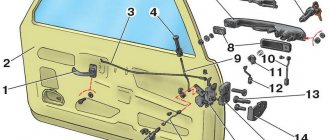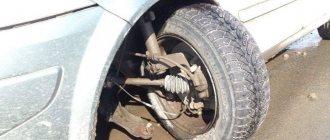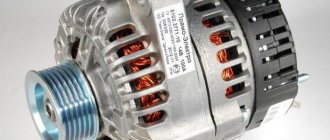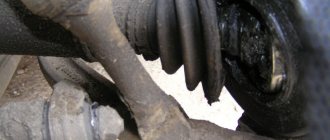Replacing the boot on the external CV joint of a VAZ 2112 car
Torque is transmitted to the drive wheel from the gearbox using the vehicle's constant velocity joint - CV joint. The operation of the running system depends on how well the unit is in good condition. Although the elements of CV joints are made of durable materials, signs of their malfunctions can appear even in cars that have recently left the assembly line of a car plant. The most common causes of breakdowns are:
- Poor quality of VAZ 2112 CV joints, use of fakes or defective parts.
- Complete absence or low quality of lubricant materials.
- Damage to the boot and, as a result, abrasive debris and moisture entering the unit.
- Aggressive car driving style.
- Poor condition of roads.
All this affects the reduction of the period when it is necessary to replace the boot of the VAZ 2112 CV joint. The article suggests how to perform the operations yourself, without the involvement of car service specialists.
Diagnostics of CV joint performance before installation
- The CV joint should be inspected visually, as well as by rotating it relative to the position of the bearings.
- If no crunching or crackling noises are detected when turning, and the presence of dirt and sand on the lubricant is minimal, then the joint can be cleaned in gasoline by soaking and cleaning.
We fill the grease into the CV joint
- Then we dry it and squeeze new lubricant into its body. This also applies to the CV joint boot, which also needs to be coated with the body.
Reasons for replacing the boot
The service life of CV joints can be reduced very quickly due to damaged boots. Dirt and dust that gets inside the “grenade” act as an abrasive.
And since the hinge elements are heavily loaded and are constantly in contact with each other, the trapped dirt very quickly damages them and the “grenade” fails.
Even if you do not check the condition of the boot, the hinge itself will signal that it is damaged.
For example, as shown in the photo below, the CV joint turned.
When making turns, the CV joint with dirt trapped in it will begin to crack loudly. If the damage is not quickly repaired, the “grenade” will soon simply disintegrate and will have to be completely replaced.
But replacing a CV joint will cost much more than a boot. Therefore, upon discovering damage to the boot, or hearing a cracking sound from the CV joint, it is better to immediately begin troubleshooting the problem.
And such a malfunction is eliminated by replacing the boot, washing the CV joint and adding new lubricant to it.
Next, we will consider the sequence of actions for replacing the external CV joint boot of front-wheel drive VAZs using model 2199 as an example.
Similar work is carried out on the VAZ 2110, 2114 models, so we hope that the owners of these cars will not have any problems after reading the article.
We choose the outer boot because it is damaged much more often than the inner one, since it is located near the wheel hub and the impact on it is more intense, therefore the chance of a crack appearing on it is greater.
What does a torn boot threaten the car owner with?
And if a rupture occurs, or cracks are already found on it, then one way or another moisture with elements of sand and dirt begins to seep inside. This will not have the best effect on the operation of the front-wheel drive system as a whole. Despite the fact that the elements are assembled from high-quality and durable materials, rupture can occur at any time.
Reasons for boot failure
Among all the reasons for the premature failure of the boot, the following can be distinguished:
- Low quality spare parts, possible presence of fakes or defective parts.
- The amount of lubricant inside is minimal , therefore, the material dries out over time.
- The driving style of the car is harsh, therefore, the boot breaks due to strong and sudden turns of the steering wheel .
- Poor quality of the road surface negatively affects the condition of the front suspension as a whole, and in particular the constant pressure on the CV joint boot.
All of the above reasons in one way or another have a negative impact on the general condition of the CV joint boot, and below we offer you a way to replace it yourself without resorting to the help of a car service center.
Why is it necessary to replace the boot?
It is known that any part is subject to wear during operation and this is due to the appearance of various cracks and gaps on its surface. These are exactly the symptoms that are characteristic of the CV joint boot. But what is a CV joint?
This is what the new CV joint and boot look like
CV joint (constant velocity joint - approx.) is a special joint equipped with transverse grooves and able to change the angle between the driven and driven axle shafts. In other words, thanks to this element, the car transmits torque from the gearbox directly to the wheels.
And over time, when the boot wears out, dust and dirt get inside the CV joint, thereby mixing with the lubricant, which leads to the formation of a kind of “crunch” when turning the steering wheel or sharply accelerating the car. In this case, the grenade itself will need to be replaced.
Additional factors that may indicate CV joint wear:
- When the car starts to move, or when the moment of movement changes, small jerks appear.
- There is play on the shaft between the inner or outer CV joint.
SHRUS device diagram
In order to study in more detail the structure of CV joints and their anthers, we offer a detailed diagram:
This is what the diagram looks like.
Thus, long-term driving with a torn boot, and even more so with a faulty CV joint, is highly not recommended. Can knock out a grenade.
Dismantling drive shafts of a VAZ 2112 car
During repair work on the steering mechanism, chassis elements of a VAZ, or during a routine inspection, you can detect cracks appearing on the boot of the outer CV joint. Over time, the boot breaks and dust and dirt enter the body, which leads to the replacement of the entire hinge. The price of such a replacement is quite high and unreasonable. Timely replacement of the CV joint boot on a VAZ 2112 will prevent such operations. To work you will need:
- The key is “17” millimeters.
- 30mm wrench.
- Balloon wrench.
- Mount.
Replacing the boot on a VAZ 2112 CV joint is easier to do on a dismantled drive shaft. For this:
- Wheel chocks are installed under the rear wheels, and the car is placed on the handbrake.
- By holding down the brake pedal (with the help of another person), the nut holding the drive shaft to the wheel hub is unscrewed.
- The bolts securing the wheels break off.
- Using a jack, the desired side is raised.
- A special support stand is placed under the car.
- The protective cap is removed by prying it off with a screwdriver.
- The engine compartment splash guard is removed.
- The plug for draining the transmission oil is unscrewed from the gearbox.
- The oil is drained.
- The bolts securing the ball joint to the steering knuckle are unscrewed, as shown in the photo.
Unscrewing the bolts securing the ball joint to the steering knuckle
- The thrust washer is removed.
- Depending on the side of the repair work, the wheels are turned to the left or right extreme position.
- The outer CV joint is squeezed out of the wheel hub.
- The condition of the boot is visually checked.
Tip: To prevent moisture from getting on the surface of the shaft assembly, it must be suspended by a suspension element using a wire.
- Holding the drive shaft with one hand, with the other, using a pry bar, the inner CV joint is pressed out of the gearbox.
Advice: If it is necessary to remove both drive shafts, before pressing out another shaft, instead of the dismantled first one, you must insert the old housing from the inner CV joint into the gearbox. Otherwise, the installation of the side gears can be disrupted, and this will make it impossible to install the drive shafts.
Replacing the CV joint boot on a VAZ 2112 car
To work you will need:
- Special lubricant.
- Hammer.
- Pliers for removing clamps.
- Screwdriver.
Replacement of anthers on VAZ 2112 CV joints is carried out using a bench vice.
- The drive shaft is very carefully fixed in a vice.
- Using a screwdriver, loosen the clamps holding the boots to the housings of the inner and outer CV joints.
The clamps are released from the CV joint housing
- If the boot needs to be replaced, it can be cut.
- Using a special bronze guide, the outer and inner CV joints are knocked off the drive shaft.
- The joints are washed with gasoline, kerosene or diesel fuel.
- The presence of damage is visually determined. If necessary, defects are eliminated.
- New boots are installed on the shaft.
- The outer CV joint housing is filled with lubricant.
- The housing is placed on the drive shaft.
- The hinge is hammered until the thrust ring is fixed.
- A special tool is used to clamp the clamp, which secures the boot to the drive shaft.
Tip: After installing the boot on the body, you need to pry it with a screwdriver and squeeze it so that all the air comes out. After this, the fastening clamp is installed and tightened.
- The boot and inner CV joint are installed on the shaft in the same way.
- A plastic plug is installed on the end of the shaft on the side of the internal hinge.
- The boot clamps are tightened.
How to replace CV joint boots on a VAZ 2112 is clearly shown in the video.
Drive Shaft Installation
So:
- The CV joint retaining ring is replaced with a new one.
- Graphite lubricant is applied to the splines.
- Carefully, without damaging the sealing collar, the hinge is inserted into the gearbox housing.
- The shaft is finally fixed in the side gear. To do this, apply a wooden block to the shaft and apply blows with a hammer along the axis of the shaft.
- The drive shaft is installed in the wheel hub.
- Next, the operations are repeated in the reverse disassembly sequence.
If the instructions are followed when replacing the anthers, then any car owner will replace the elements correctly and quickly enough. After all the operations performed, do not forget to top up or change the oil in the gearbox.
Preparation
So, damage to the boot on the VAZ 2199 has been identified. You can replace it and wash the CV joint itself in the garage, the main thing is that there is an inspection hole.
Tools you will need:
- Set of wrenches (socket wrenches, open-end wrenches);
- Set of heads and collars;
- Metal brush;
- WD-40;
- Mount;
- Hammer;
- Jack;
- Wheel chocks;
- Wooden coasters.
You will also need a new boot, CV joint grease-4, a container for collecting oil, a container with gasoline for washing the CV joint, and rags.
Order of Operations
If there is no inspection hole or overpass, you need to prepare a place for repairs. Raise the car with a jack, put on the handbrake, provide the work area with good lighting, and support the wheels with clamps.
Replacing the inner CV joint of the VAZ 2110 and other models is carried out in the same way as the outer joint. They are both located on the shaft drive, which you need to get to first:
- On the crankcase protection, two nuts are unscrewed at the front and rear.
- You need to drain the oil from the box - 40 percent of the total volume.
- When replacing the right CV joint on a VAZ 2110, the wheel bolts come off on the right; if the left one is changed, the wheel bolts come off on the left.
- The outer hinge fasteners are completely unscrewed.
- Now you still need to jack up the car and remove the wheel.
At this stage, two hub bolts securing the grenade become accessible; they need to be removed.
- The hub needs to be separated from the rods, this is done with a pry bar.
- The stand is pulled forward and the CV joint pin is removed from the hub.
- The shaft drive is removed and set aside.
Now you need to remove the inner grenade from the box. With the hood open, you need to insert a pry bar between these elements. Then the tool jerks the hinge towards the box. The grenade should move. If this does not happen, the operation is repeated again. If the CV joint moves, then both hinges and the shaft can be removed from the wheel arch area. - You need to remove the covers from the grenades; to do this, use pliers or special pliers to open the small and large clamps.
- The boot must be inspected for integrity. If the cover is damaged, it must be replaced. If the boot is in good condition, you can simply move it away.
Use a hammer to remove the inner hinge. They need to hit the clip hard. The grenade should fly off. The same action must be performed on the other side.The rings are removed from the shaft drive, new ones are installed in their place and the boot is put on.
- The new grenade is also installed using a hammer. It and the boot need to be lubricated.
- The covers are secured to the hinge and shaft with clamps.
- A nut is screwed onto the grenade, then the hinge is driven into the box.
- Further operations are similar to the first, but are performed in reverse order.
See this video for the sequence of replacing the outer and inner CV joints of VAZ 2110 2111 2112:


